SmallBASIC KNOWLEDGE OF THE IGNITION SYSTEM OF A TYPICAL INTERNAL COMBUSTION COMBUSTION ENGINE E.G AUTOS
Imagine waking on a Monday morning when you have to get to your place of work before 09:00 and it’ll take you say 40 minutes to drive. Then you switch on your car engine at 08:15 and it refuses to come on, you’d know you’re in for a long thing. Therefore, it’s not a big deal that you have an ideal knowledge of how a typical I.C (i.e internal combustion) engine ignition system works. It is not a minus but definitely a plus as you can see to minor issues by yourself.
Since this is just a post for basic knowledge, I’ll be taking us through some fundamentals and get just a little deeper in the course of this article. I’m going to be explaining what an ignition system is and what it does, the different types of ignition systems and also basic maintenance of your ignition system, I bet it’s gonna worth your time.
WHAT AN IGNITION SYSTEM IS AND WHAT IT DOES
In lay man’s term, it’s easy to say an ignition system is that part of an I.C engine that makes the whole engine work by turning on the power the engine needs to start running. But there’s more to the ignition system than just that. We can also say an ignition system is a system in an engine that consists of mechanisms which work together to ignite an air-fuel mixture in the combustion chamber of the engine.
There are different classifications and types of ignition systems but in this post, i’d discuss three main types which are the battery/coil ignition system, the electronic ignition system and then the magneto ignition system
COMPONENTS OF AN IGNITION SYSTEM
The components of an ignition system runs from the battery (for battery ignition system only) down to the spark plugs but sure includes a lot of other components that make up the system. Let's discuss some of the components. They include:
Ignition switch(for battery ignition system only), Ignition coil, the circuit or contact breaker, capacitor/condenser, the distributor and then to the well known set of spark plugs. Magneto is also used in the magneto ignition system only
BATTERY IGNITION SYSTEM
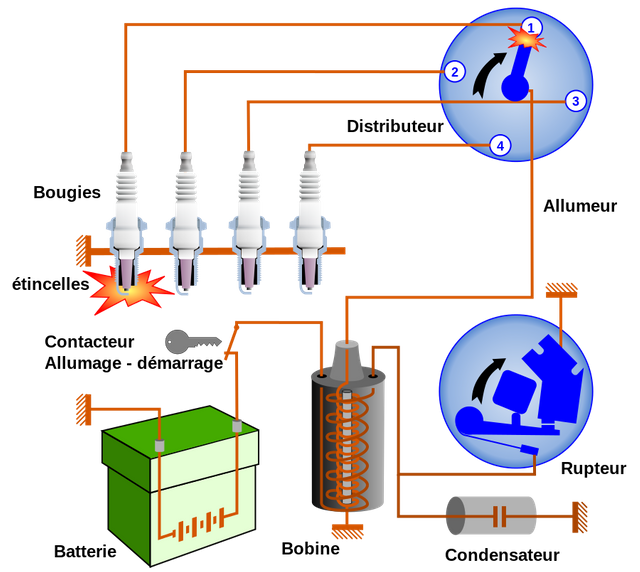 Allumage_batterie by Frédéric MICHEL Creative Commons Attribution-Share Alike 3.0 Unported, 2.5 Generic, 2.0 Generic and 1.0 Generic
Allumage_batterie by Frédéric MICHEL Creative Commons Attribution-Share Alike 3.0 Unported, 2.5 Generic, 2.0 Generic and 1.0 Generic
BATTERY: Battery is something we use to store power in most gadgets used on daily basis, so I believe I wouldn't be saying a new thing by telling you a battery is a device containing electrical cell(s) used to power any electronics. A car battery can be rated ranging from 12V to 20V (15V is typical) to generate a high voltage that may have thousands of voltage. The battery which stores electrical energy has one of its terminal ground while the other one is connected to the ignition switch which uses the ignition key to turn on and off the ignition.
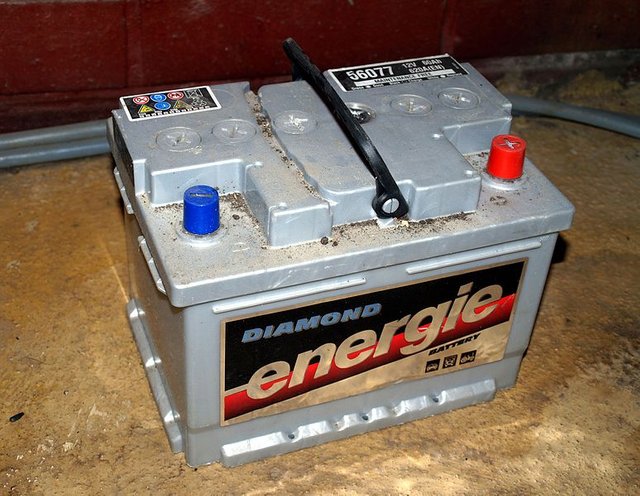 Diamond energy car battery by Santeri Viinamäki under Creative Commons Attribution-Share Alike 4.0 International
Diamond energy car battery by Santeri Viinamäki under Creative Commons Attribution-Share Alike 4.0 International
IGNITION SWITCH: The ignition switch or better still called the starter switch is a switch that activates the electrical system for the engine. It provides power for the ignition coil. It requires a key to be inserted that works a lock built into the switch mechanism. Usually in almost all cases, the ignition switch key is the same lock key for the car’s door. 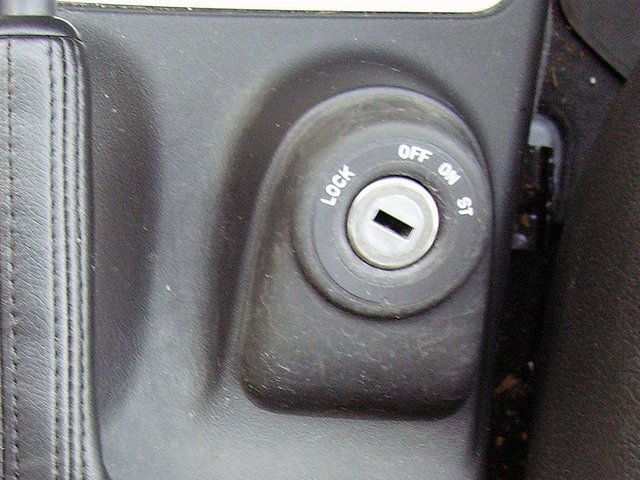
IGNITION COIL: An ignition coil is a coil on the ignition system that works on the operation of electromagnetic induction. It also does the work of a step-up transformer as it steps up the car’s low battery voltage to a very high one around 6000-15000V which is the needed voltage to create a spark in the distribution chamber (by means of a high tension wire carrying high voltage) and also in the spark plugs. The ignition coil has a magnetic soft iron core and two insulated conducting coils which are the primary and secondary windings. The primary windings (with thicker gauge wires) may have up to 200-300 turns while the secondary windings (with fine wires) may have around 21000 turns. Both ends of the primary windings are connected to the external terminals. The secondary windings has one of its terminal connected to the primary winding while the other is connected to a high tension wire which passes high voltage to the distributor.
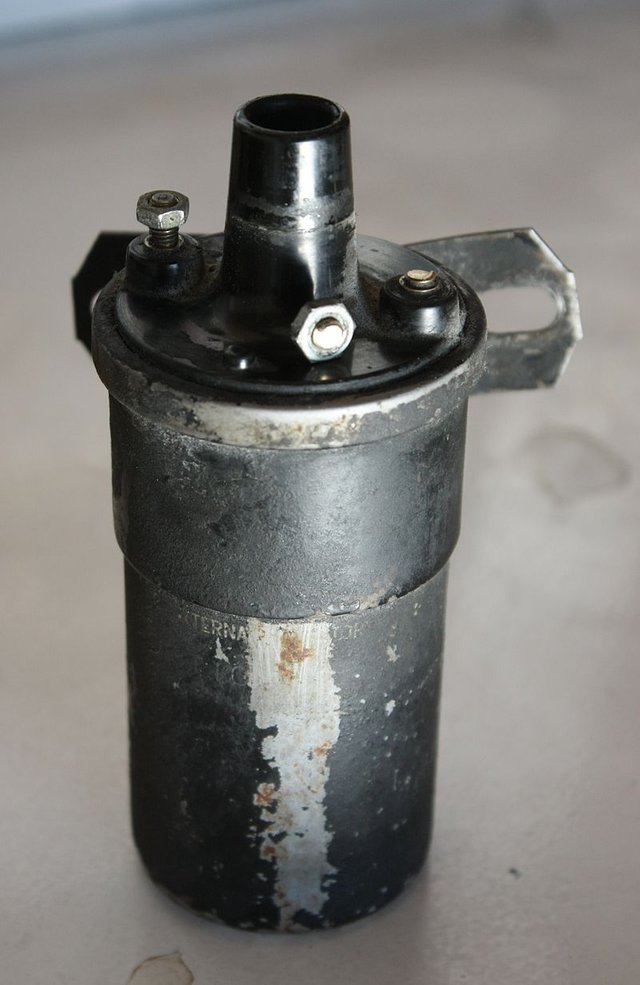 Ignition coil by Nick Ares under Creative Commons Attribution-Share Alike 2.0 Generic license.
Ignition coil by Nick Ares under Creative Commons Attribution-Share Alike 2.0 Generic license.
CIRCUIT BREAKER: Is a mechanical device used for opening and closing the primary circuit that’s in the ignition coil. It has two metal points, one fixed, the other movable. The movable metal points is connected to a spring loaded pivot arm. The spring keeps the metal points together by so doing, closes the primary circuit. A condenser is connected in series to the circuit breaker assembly to prevent wear of metal due to friction.
CAPACITOR/CONDENSER: Out of the knowledge of automotives, as a science student, you’ve done one physics practical or the other and probably simply know a capacitor as a device for storing electrical energy. That’s exactly what the condenser/capacitor does in the sense of the ignition system. It stores electricity as the breaker points open and returns electricity to the primary as the breaker point is closed. The condenser also helps in preventing burning of the metal plates caused by contact.
DISTRIBUTOR: As the name suggests, the function of the distributor is to distribute at precise timing, uniform ignition surges to each spark plug metallic electrode. The surges are transferred to the distributor through the high tension wire connected to it from the secondary windings of the ignition coil. It has a rotor in the middle that causes it to rotate and give sparks to each plug’s metallic electrode in the distributor.
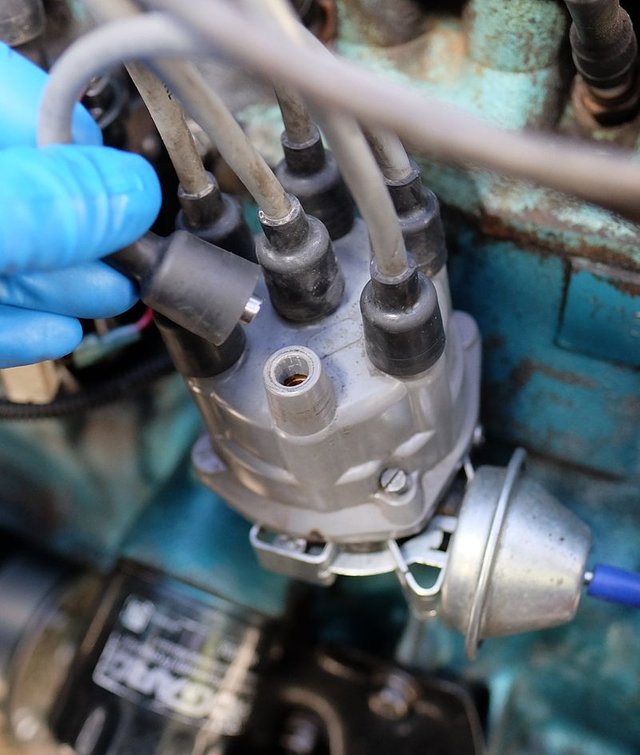 Image by Dennis Bratland under Creative Commons Attribution-Share Alike 4.0 International
Image by Dennis Bratland under Creative Commons Attribution-Share Alike 4.0 International
SPARK PLUGS: Yeah! Spark plugs, the part at least anybody will know belongs to the ignition system. It’s the only external part. They have two electrodes: the central electrode and the ground electrode. They receive ignition surges from their metallic electrode connected to them from the distributor. It thereby gives sparks at precise timing to ignite air-fuel mixture in the combustion chamber.
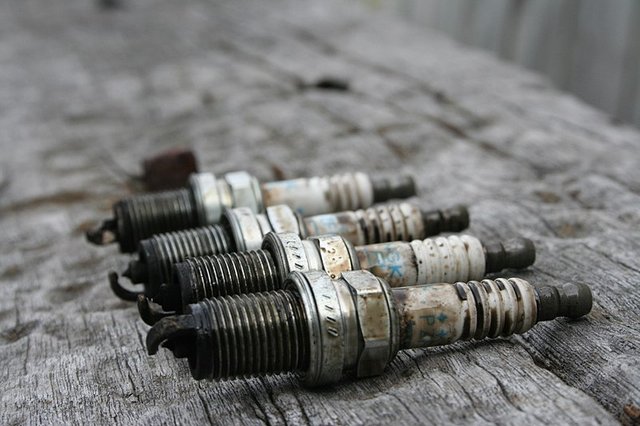 Spark plugs by Aidan Wojtas under Creative Commons Attribution-Share Alike 2.0 Generic
Spark plugs by Aidan Wojtas under Creative Commons Attribution-Share Alike 2.0 Generic
MAGNETO IGNITION SYSTEM:
MAGNETO: A magneto is like an alternator with permanent magnets. According to Thefreedictionary.com magneto is defined as “a device that produces alternating current for distribution to the spark plugs, used in the ignition systems of some internal-combustion engines.”
In the magneto ignition system, energy is generated through the magneto instead of the battery in case of battery ignition system also, electric field is produced by a rotating permanent magnet present in the core of the windings. When the engine is started, the permanent magnet rotates and the field is produced from positive maximum to negative maximum. The magneto is rotated which in turn produces voltage that is high enough to power the engine depending on fast the rotation. Other components of battery ignition system is present in magneto ignition system.
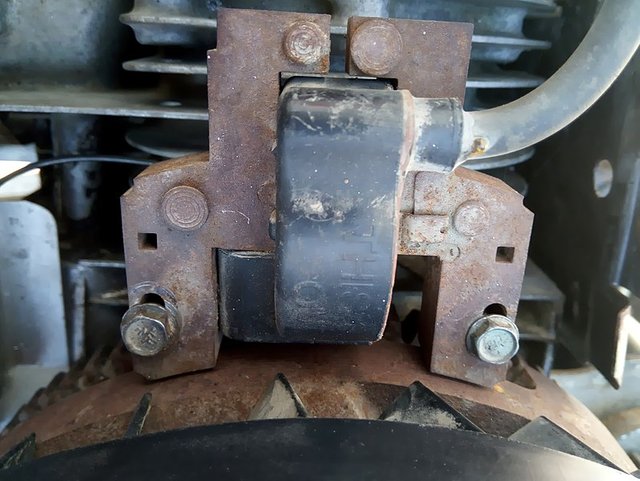 Image by A7N8X under Creative Commons Attribution-Share Alike 4.0 International license.
Image by A7N8X under Creative Commons Attribution-Share Alike 4.0 International license.
ELECTRONIC IGNITION SYSTEM: When you hear the word “electronic”, what comes to your mind? Obviously, voltage, current, replacements of certain initial mechanical parts with an electrical one and all sort. An electronic ignition system aka transistor ignition system. Why? Because a transistor is used to control the flow of electricity from primary coil to the ECU (Electronic Controlled Unit) and then to the sensor. You’ll get to know all those terms as I explain later in this article. As conventional battery ignition system tends to prove undependable (due to plates burning when primary current is passed) over the cause of time, there arises the need for a more dependable ignition system. In the electronic ignition system, we don’t have to worry over mechanical breaker plates burn caused by contact in opening and closing of the plate. This also helps in preventing timing problems.
Now, here’s how an electronic ignition system works, when you switch on your engine, current is passed from the battery through the ignition switch to the primary of the ignition coil which then passes current to a rotating armature that has teeth. There’s a presence of a sensor that senses the charged armature teeth and sends signals to the ECU which does the work of the circuit breaker as in the battery ignition coil. As the teeth is sensed, the ECU is caused to break the transfer of voltage, when the teeth is away and not sensed, the ECU opens the transfer of voltage. This process occurs within milliseconds causing a make and break of voltage which results in the induction of an emf in the secondary of the ignition coil and causes a multiplied voltage of thousands worth sent to the distributor where other operations are completed as though it were a battery ignition system.
PROS AND CONS OF THE DIFFERENT TYPES OF IGNITION SYSTEM
BATTERY/COIL IGNITION SYSTEM: The number one thing that makes the battery ignition system so common and widely used is the fact that it is less expensive when compared to the magneto ignition system. Another advantage is that it requires less maintenance and battery can also be used to power other electronic parts of the vehicle e.g headlamps.
Just as the internet or any other aide has massive advantages, it also has its own shortcomings. A bad side of BIS is wear a d burn in contact breaker due to rubbing over of both metal points and thereby reduces maintenance interval. Another fact is that it is not reliable of high speed engines because as speed increases, primary voltage reduces and cannot create a spark.
Don't use your car as a phone charger when not driving otherwise it can get drained.
MAGNETO IGNITION SYSTEM: The magneto ignition system covers for the cons of the battery ignition system by being more useful at at medium and high speed, also, since it does not require external medium for power generation, it requires less maintenance. But to cover up for a problem is an extra expense. It is costly compared to the battery ignition system. Due to low rotating speed at the start of the engine, there's starting problem. Probability of misfire due to voltage leakage.
BASIC MAINTENANCE OF THE IGNITION SYSTEM
One thing a typical car owner knows about the maintenance of his ignition system is the cleaning or replacing of spark plugs after a certain amount of mileage or after a specified period of time based on what the manufacturer specifies. But the maintenance of an ignition system goes far beyond that. I'll briefly explain some faults your ignition system can develop and how you can fix them.
For spark plugs as earlier mentioned, they can develop carbon or ash deposit on their tips. When something like this is observed, clean it and reinstall it. After a mileage given by the car manufacturer, get new ones.
If your car doesn't start or doesn't give a nice sound when you switch it on, it maybe due to a wrong timing, for this, except you have a service manual on how to set your timing, I'll say, take it to a mechanic shop. It shouldn't take much time and bam! You're on the road again. Also, we know the ignition system comprises of electrical wires that runs from the battery to different components, so, unless the cause of the problem is known, visit your mechanic.
Thanks for going through this post, feel free to drop comments.
Sources:
https://www.mechgrid.com/magneto-ignition-system-parts-working-advantages-disadvantages.html
https://en.m.wikipedia.org/wiki/Ignition_system
https://auto.howstuffworks.com/under-the-hood/car-part-longevity/how-long-ignitions-last2.htm
http://mgaguru.com/mgtech/ignition/ig203.htm
http://arrc.ebscohost.com/ebsco_static/repair-tips/8852CH13_ELECTRONIC_IGNITION_SYSTEMS.htm!
Modern Automotive mevhanics by James E. Duffy
This post has been voted on by the steemstem curation team and voting trail.
There is more to SteemSTEM than just writing posts, check here for some more tips on being a community member. You can also join our discord here to get to know the rest of the community!
Thanks
Hi @pheelz!
Your post was upvoted by utopian.io in cooperation with steemstem - supporting knowledge, innovation and technological advancement on the Steem Blockchain.
Contribute to Open Source with utopian.io
Learn how to contribute on our website and join the new open source economy.
Want to chat? Join the Utopian Community on Discord https://discord.gg/h52nFrV